Shanghai Stories: Quite the city!
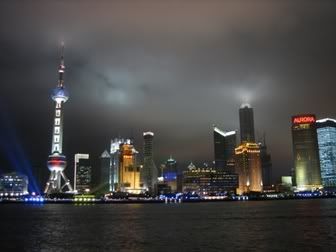
Bright lights + big city + Chinese fascination with neon = Shanghai! This is Pudong, the "newer" district of China's would-be business capital.
New York City is the biggest city in the U.S. of A at a respectable 8 million people. Shanghai is the largest city in the People's Republic at a massive 16-plus million...and growing.
Wowee.
I enjoyed my time in Shanghai. It was pretty much what one might expect of a big city - I spent quite a lot of time looking at big buildings and walking around brightly neon-lit shopping districts. The city is really very cosmopolitan, due in part to its colonial past. It seemed appropriate, then, that my journey began on a German train.

Ready to fly on a magnetic track?
OK, it is lame that I took a picture of the Maglev poster to represent my ride on it, but - trust me - the poster is much more impressive than the train itself. Actually, let me rephrase: the train is pretty cool...inside. Outside it looks rather unspectacular (go figure). But the fact that the train can hit top speed of 430 kilometers per hour is pretty neat. Um, I guess. As I expected, the Maglev ride was anticlimatic: 8 minutes, with less than 30 seconds at the top speed. Obviously, it's just a show of modernity. A 50RMB (that's RMB = Renminbi, aka kuai...about US$6.25) show. At least I got to keep myself amused by this guy on the train:
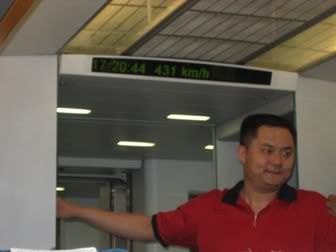
This one's for the grandkids.
It was my humorous re-introduction to how much Chinese people love taking pictures of seemingly pointless things. Oh, how could I ever forget?!? Anyhoo, each car of the Maglev train has a display to show passengers how fast the train is going. The dude above kept telling his friend to take a picture of him by the speedometer display. First at 250 km/hr...then at 320...("Oh, no, wait! It goes faster!")...then at 399...then 429...("Wait! It goes up to 430! Wait 'til it goes up to 430!!")...and finally at 430 km/hr ("Hurry up and take the picture before it slows down!"). Of course, I had to take the opportunity to capture this moment. After all, I'm Chinese, too. :)
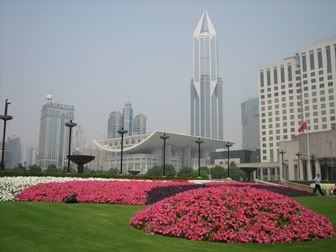
Gardening tip #1: Nothing brightens up hazy polluted vistas like a manicured lawn with pink flowers.
Maybe I've forgotten what the streets of Beijing look like, but I found Shanghai to be clean, green, and very wide. The streets are impressively wide! And the pollution isn't nearly as bad as Beijing.

I had a flashback when I saw this sign and started convulsing in the street, all the while foaming at the mouth...just kidding! I think...
As every good youke (tourist) must do, I took a stroll for several hours on the Bund, which is basically all the classic colonial-power-built business buildings of Old Shanghai. Imagine my surprise to find my old employer's Shanghai branch! Just FYI, ABN AMRO's Chinese name is translated simply as "Dutch Bank."
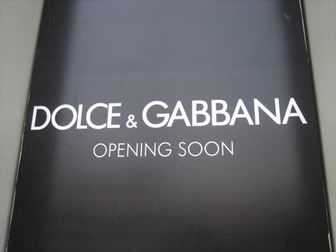
More taking pictures of pointless signs in the street! Hey, I really am Chinese!
The building that is going to house this Dolce & Gabanna is huge They don't build stores like this because of the demand from foreign tourists...in case you had any doubt how rich the Chinese are getting!
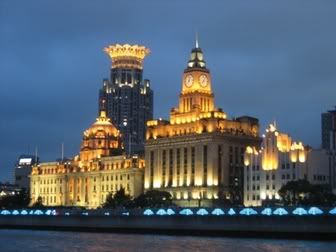
The Bund at night, in all its Bundy goodness.
The Bund is lovely, especially when lit up at night. Here are the two classic buildings of the street: the old Customs House and the old HSBC bank. In my opinion, the Bund really resembles Chicago's Michigan Avenue (around the Wrigley building, for those "in the know"), so much that, when I was strolling along, I just kinda shrugged my shoulders and thought, "I think I've seen this before!" Still, I love looking at old architecture, so it was quite fun to walk around.

Mmm...small birds on sticks.
Thanks to a certain set of Shanghai-born Chicago twins, I got hooked up with Edith (above) and her mom. They were the cutest, sweetest people ever! Besides inviting me into their home, showing me around, and refusing my money, they also introduced me to the wonders of Shanghainese street food, such as fried sparrow on a stick shown here! You can eat the bones!
An aside on Urban Planning (and general government power) in the People's Republic
I mentioned in my last post that Shanghai was really quite fascinating from a urban planning point of view. And, seeing that one faithful reader even expressed interest in learning more about this (thanks for indulging me, Panda!), here we go!
You should first know, faithful readers, that Shanghai has historically been quite an international city. This is due to the fact that, when China opened (or, depending on your point of view, was forced opened) to the West in the 19th century, many colonial powers came in and basically divied up the city into their own spheres of influence. As the city was eventually built into the "Paris of the Orient," a glamorous if capitalistic representation of the Far East.
Then the Commmunists took power in 1949, and for many years Shanghai's development - economically, culturally, architecturally - lagged. The British (one of those colonial powers with great influence in Old Shanghai) concentrated their efforts in further developing Hong Kong. Japan, Korea, Taiwan, and Singapore took off in their own ways, too.
If history was different, Shanghai may have developed into the economic center of the Far East. Alas, history can be a cruel bee-otch. I think that the Communist Party in China has realized this (as they well should, since the lag of development is partly their fault...but I digress...and plus, I'm probably being watched by some Chinese internet security!). Thus, Shanghai has been - and indeed is - undergoing the quickest development of any city in recent history.
The heart of the city is found on the banks of the Huangpu river. The west bank is where the famous Bund is located. Much newer is the Pudong business district on the east bank, and the construction here is, in a word, mad. The government wants Shanghai to be the premier business capital of Asia, and Pudong shows it. High rise office buildings abound, with more being built by the day. The Pudong area is also being built up with luxury high-rise apartments all along the banks of the river, replacing old riverside port warehouses, which are being razed alongside old low-rise residences.
At night (partly, I've long discovered, thanks to the Chinese's fascination with neon and bright lights), the Bund and Pudong are lit up in a dazzling display of modernity and wealth. Both banks of the Huangpu sparkle, and it's hard to imagine that the sky above Shanghai could ever be totally dark with such a luminous display. Still, along the southern end of the river, the banks are still dark, as shuttered warehouses are still standing, waiting for demolition. Indeed, some parts of the city which still hold older residences look pitch black against the brightness of the Bund and Pudong.

Because a lot of construction takes place along the riverbanks of the Huangpu River and there is little space on land, huge barges with cranes and building equipment are docked in the river during the construction of the new buildings.
In two or three years, I doubt that any part of the Huangpu's banks - or much of Shanghai, for that matter - will be dark. The plan is to build the city into an (even more) modern one, with the banks of the river replete with high rise luxury apartments and commerical buildings. Richer residents can live in luxurious single-family homes in outer Pudong, and poorer local residents will likely be pushed out further into the city edges in high-rise block apartments.
In America, this type of razing-and-building would take years, with developers having to buy land from the owners of businesses and residences, getting proper licences, and eventually building. In China, the process is considerably shorter, since the PRC government simply says, "We're relocating you! Suck it up!" and then starts the whole building process. Plus, given the availability of manpower and, well, strong desire to develop the city, this means buildings can be up in a matter of months.
This type of government power is pretty incredible. I got a good taste of it while I was actually in Shanghai. I was staying with an old friend from college, Kristen, who informed me that the Shanghai city government was declaring a 5-day holiday from Wednesday to Sunday (June 14-18), because there was an scheduled Shanghai Cooperation Organization)conference of political leaders in the city. The entire Bund was effectively closed down so that the politicos could move freely about the city. I found this to be pretty crazy! We Americans would step up the security for political conferences and people would be pissed off at the traffic jams, but shutting down an entire city is almost unimaginable to me! Edith and her mom ironically remarked that maybe the government didn't really want regular Chinese folks to be walking around with the politicos. Hmmm, interesting. Anyhoo, they also informed me nonchalantly that their apartment will be getting torn down in a couple of years, so maybe they will need to start finding a new place to live.
::Sigh::
Anyhoo, quasi-political soapbox aside, if you are in Shanghai and want to learn more about the city's urban planning, they actually have a museum (or is it "exhibition center"?) on all this stuff! Pretty spiffy architecture job on the place, too!
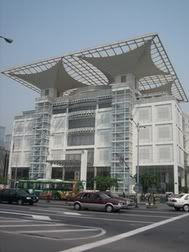
One last note...
It's official: the U.S. is probably the only place in the whole wide world (maybe universe) where people don't care about the World Cup (or should I say Shijie Bei. The many channels of CCTV have nightly reports on the weather conditions in Germany, people! Come on, America! Why don't you like football/soccer?!?!

3 Comments:
wahaha! I love the bird on a stick *wink*
Jenny
Bird-on-a-stick! Awesome. Heh. I wonder if Julie could develop a muffin recipe involving... never mind.
ewww....
Post a Comment
<< Home